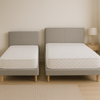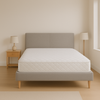The All-Terrain Mattress Guide: Camping, Glamping Beyond
- by Giorgi Gogidze

Whether you’re a rugged backpacker or a luxury glamping enthusiast, the right camping mattress can make all the difference in sleep quality. From ultralight pads to plush inflatable beds, this guide covers the best mattress options for every terrain, weather condition, and camping style, ensuring comfort no matter where the trail (or tent) takes you.
[toc]
Key Advantages and Features
• Lightweight Options: Foam and air mats for minimalist hikers
• Luxury Comfort: Inflatable beds and padded toppers for glampers
• High R-Values: Insulated mattresses for cold terrain
• Durable Materials: Ripstop fabric and reinforced seams for rugged use
• Portable Designs: Compresses or folds easily for travel
• Custom Fit: Sized for tents, hammocks, SUVs, or rooftop tents
• Fast Inflation: Manual, self-inflating, and pump-assisted models
• Versatile Thicknesses: From 1-inch ultralight to 6-inch plush pads
• Water-Resistant Layers: For wet ground or dew-prone mornings
• Back, Side & Combo Sleeper Friendly: Options for every position
Defining Your Camping Style
Your mattress choice starts with your camping style:
-
Backpacking: Prioritizes weight and packability
-
Car Camping: Allows for thicker, heavier comfort options
-
Glamping: Luxury-focused with full-sized inflatable or memory foam mattresses
-
Overlanding or SUV Camping: Needs foldable or custom-fit mats for vehicle interiors
-
Festival Camping: Portable but cushy options ideal for multi-day use
Understanding your base setup, sleep expectations, and physical needs will narrow down the ideal type of camping mattress for you.
Types of Camping Mattresses
There’s no one-size-fits-all when it comes to outdoor sleeping pads. The most popular types include:
-
Closed-Cell Foam Mats: Lightweight, durable, and reliable. Great for layering or ultralight trips.
-
Self-Inflating Pads: Foam-filled and convenient. They balance weight, comfort, and insulation well.
-
Air Pads: Adjustable firmness and compact. Ideal for warmer climates but require care to avoid punctures.
-
Camping Air Mattresses: Thicker and taller than air pads. Perfect for car camping or glamping setups.
-
Folding Mattresses: Good for vehicle camping or family tents. Foam-based with easy storage.
-
Mattress Toppers or Pads: Add comfort over camp cots or existing mattresses in tents, vans, or cabins.
Terrain and Weather Considerations
Where and when you camp affects which mattress you should bring:
-
Cold Ground: Choose a high R-value pad (R-4 or higher) with insulated foam
-
Rocky Terrain: Closed-cell foam or reinforced air pads reduce pressure points
-
Wet Conditions: Look for waterproof or moisture-resistant bottoms
-
Sand or Soft Soil: Thicker air mattresses hold better shape and offer more support
-
High Altitude or Wind: Self-inflating options are better than regular air mattresses, which can shrink in cold
Camping comfort starts from the ground up—literally.
[moorcroft-banner]
Weight, Packability, and Inflation
A key trade-off in mattress choice is between comfort and pack size:
-
Ultralight: Foam and minimalist air pads weigh under 1 pound and roll small
-
Midweight: Self-inflating pads range from 1.5 to 3.5 pounds
-
Heavyweight: Air mattresses and foam foldables can weigh 5 to 10+ pounds
Inflation methods vary too:
-
Manual Blow-Up: Lightweight but effort-intensive
-
Self-Inflating: Great balance of ease and portability
-
Battery or Pump-Inflated: Fastest but requires extra gear
-
No Inflation: Closed-cell mats and foldables require no setup time
Match inflation type with your endurance, power availability, and trip duration.
Comfort Levels by Activity
Not all sleep surfaces suit every activity. Here’s what works best for each:
-
Backpacking: Thin foam or compact air pads for minimal weight
-
Multi-Day Hikes: Self-inflating pads with insulation for comfort and recovery
-
Glamping & Car Camping: Large air beds or folding foam mattresses
-
Family Trips: Multi-person inflatables or cot-compatible designs
-
Rooftop Tents/Truck Beds: Slim folding pads or roll-out memory foam
Extra comfort accessories—like pillows, sheets, or mattress toppers—are worth packing for longer stays or glamping setups.
Choosing Based on Sleeping Habits
Your sleep style matters even outdoors:
-
Side Sleepers: Need thicker pads (2.5”+) to cushion hips and shoulders
-
Back Sleepers: Medium thickness with lumbar support
-
Stomach Sleepers: Firmer, thinner pads prevent sinkage
-
Toss-and-Turners: Look for wider pads or ones with grip strips to reduce slipping
Also consider noise: some pads crinkle more than others and can disturb light sleepers.
Conclusion
A restful night outdoors depends on choosing the right mattress for your terrain, camping style, and body. Whether you’re hiking light, glamping in luxury, or road-tripping through rugged landscapes, there’s an all-terrain mattress to keep you comfortable from sunset to sunrise. Invest in the right sleep gear, and you’ll wake up ready for adventure.




